| Lesson 5 | EJB Course resources |
| Objective | Explore course resources. |
EJB Course Resources
Numerous resources are offered with this course that will help you complete it successfully.
In addition to the orientation, several other resources are available to you.
In addition to the orientation, several other resources are available to you.
Entity Beans Glossary
Throughout this course, you will have the opportunity to review definitions of key terms.
These terms are defined in the course glossary. The terms appear as blue, italicized, and underlined in the lesson text.
Entity Beans Glossary
These terms are defined in the course glossary. The terms appear as blue, italicized, and underlined in the lesson text.
Entity Beans Glossary
Brief History of Java EE
Figure 1-5 summarizes 14 years of Java EE evolution and Java EE was formerly called J2EE. J2EE 1.2, was first developed by Sun, and was released in 1999 as an umbrella specification containing ten Java Specification Requests. At that time people were talking about CORBA, so J2EE 1.2 was created with distributed systems in mind. Enterprise Java Beans (EJBs) were introduced with support for remote stateful and stateless service objects, and optional support for persistent objects (entity beans). They were built on a transactional and distributed component model using
RMI-IIOP (Remote Method Invocation - Internet Inter-ORB Protocol)as the underlying protocol. The web tier had servlets and JavaServer Pages (JSPs), and (JMS) Java Message Service was used for sending messages.
